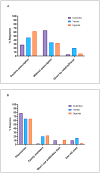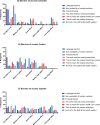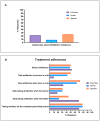Access to and utilisation of antimicrobials among forcibly displaced persons in Uganda, Yemen and Colombia: a pilot cross-sectional survey
- PMID: 39013652
- PMCID: PMC11253744
- DOI: 10.1136/bmjopen-2024-084734
Access to and utilisation of antimicrobials among forcibly displaced persons in Uganda, Yemen and Colombia: a pilot cross-sectional survey
Abstract
Objectives: Identifying key barriers to accessing quality-assured and affordable antimicrobials among forcibly displaced persons in Uganda, Yemen and Colombia and investigating their (1) utilisation patterns of antibiotics, (2) knowledge about antimicrobial resistance (AMR) and (3) perception of the quality of antimicrobials received.
Design: Pilot cross-sectional survey.
Setting: Data were collected from five health facilities in the Kiryandongo refugee settlement (Bweyale, Uganda), three camps for internally displaced persons (IDPs) in the Dar Sad district (Aden, Yemen) and a district with a high population of Venezuelan migrants (Kennedy district, Bogotá, Colombia). Data collection took place between February and May 2021. The three countries were selected due to their high number of displaced people in their respective continents.
Participants: South Sudanese refugees in Uganda, IDPs in Yemen and Venezuelan migrants in Colombia.
Outcome measure: The most common barriers to access to quality-assured and affordable antimicrobials.
Results: A total of 136 participants were enrolled in this study. Obtaining antimicrobials through informal pathways, either without a doctor's prescription or through family and friends, was common in Yemen (27/50, 54.0%) and Colombia (34/50, 68.0%). In Yemen and Uganda, respondents used antibiotics to treat (58/86, 67.4%) and prevent (39/86, 45.3%) a cold. Knowledge of AMR was generally low (24/136, 17.6%). Barriers to access included financial constraints in Colombia and Uganda, prescription requirements in Yemen and Colombia, and non-availability of drugs in Uganda and Yemen.
Conclusion: Our multicentred research identified common barriers to accessing quality antimicrobials among refugees/IDPs/migrants and common use of informal pathways. The results suggest that knowledge gaps about AMR may lead to potential misuse of antimicrobials. Due to the study's small sample size and use of non-probability sampling, the results should be interpreted with caution, and larger-scale assessments on this topic are needed. Future interventions designed for similar humanitarian settings should consider the interlinked barriers identified.
Keywords: Cross-Sectional Studies; Health Services Accessibility; INFECTIOUS DISEASES; MICROBIOLOGY; PUBLIC HEALTH; Pharmacology.
© Author(s) (or their employer(s)) 2024. Re-use permitted under CC BY-NC. No commercial re-use. See rights and permissions. Published by BMJ.
Conflict of interest statement
Competing interests: None declared.
Figures



Similar articles
-
Changing patterns of family formation among internally displaced populations in Yemen: evidence from cross-sectional surveys.BMC Public Health. 2024 Dec 3;24(1):3365. doi: 10.1186/s12889-024-20889-9. BMC Public Health. 2024. PMID: 39627745 Free PMC article.
-
Perceptions about human rights, sexual and reproductive health services by internally displaced persons in northern Uganda.Afr Health Sci. 2009 Oct;9 Suppl 2(Suppl 2):S72-80. Afr Health Sci. 2009. PMID: 20589110 Free PMC article.
-
Health and well-being of refugees, asylum seekers, undocumented migrants, and internally displaced persons under COVID-19: a scoping review.Front Public Health. 2023 Apr 26;11:1145002. doi: 10.3389/fpubh.2023.1145002. eCollection 2023. Front Public Health. 2023. PMID: 37181725 Free PMC article.
-
Assessing equity of access and affordability of care among South Sudanese refugees and host communities in two districts in Uganda: a cross-sectional survey.BMC Health Serv Res. 2022 Sep 16;22(1):1165. doi: 10.1186/s12913-022-08547-5. BMC Health Serv Res. 2022. PMID: 36114536 Free PMC article.
-
An overview of systematic reviews on mental health promotion, prevention, and treatment of common mental disorders for refugees, asylum seekers, and internally displaced persons.Cochrane Database Syst Rev. 2020 Sep 4;9(9):CD013458. doi: 10.1002/14651858.CD013458.pub2. Cochrane Database Syst Rev. 2020. PMID: 32885850 Free PMC article.
Cited by
-
Biofilms as potential reservoirs of antimicrobial resistance in vulnerable settings.Front Public Health. 2025 Mar 21;13:1568463. doi: 10.3389/fpubh.2025.1568463. eCollection 2025. Front Public Health. 2025. PMID: 40190753 Free PMC article.
-
Antimicrobial Resistance and Migration: Interrelation Between Two Hot Topics in Global Health.Ann Glob Health. 2025 Mar 6;91(1):12. doi: 10.5334/aogh.4628. eCollection 2025. Ann Glob Health. 2025. PMID: 40061583 Free PMC article. Review.
References
-
- World Health Organization Global action plan on antimicrobial resistance. 2015. [14-Oct-2023]. https://www.who.int/publications/i/item/9789241509763 Available. Accessed. - PubMed
Publication types
MeSH terms
Substances
LinkOut - more resources
Full Text Sources
